The seven pictures that decorate the hall are symbolic expressions for quite specific ancient truths. They represent the so-called seven seals of ancient, and ever new, wisdom. This is spoken of in the Apocalypse of John, and this Apocalypse is a kind of interpretation of an esoteric symbol language. Whoever studies the seals will recognise the images in the visions of the writer of the Apocalypse. Every letter, every colour of the seals means something. When we look at them together in the right way and sense the connection, quite specific feelings are released, which can engender an inner strength. (Rudolf Steiner, GA 284 - 21st of May 1907)
Click image to open full-size in a new window.
The first set of images are provided as a background history for Arild Rosenkranz's versions of the Seven Seals.
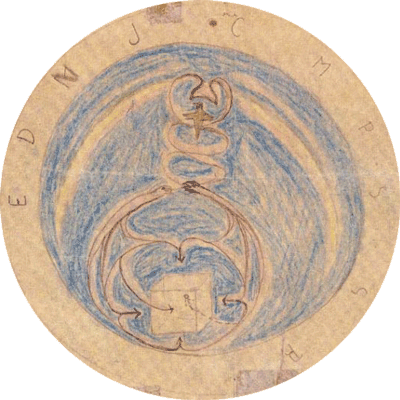
Rudolf Steiner's sketch of the Seventh Seal. The letters around the seal refer to the Rosicrucian Ex Deo Nascimur, In Christo Morimur, Per Spiritum Sanctum Reviviscimus — taken from the Fama Fraternitatis (though originally therein as Ex Deo nascimur, in Jesu morimur, per Spiritum Sanctum reviviscimus). This last seal Steiner talks of as the Holy Grail.
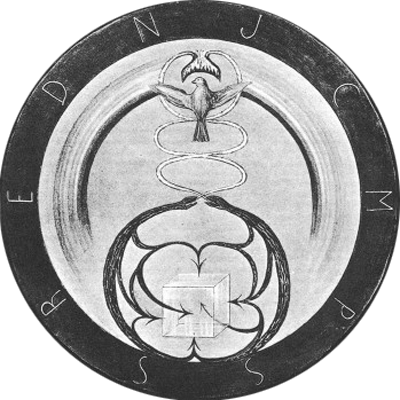
The following are the Seven Seals painted by Clara Rettich in 1911.

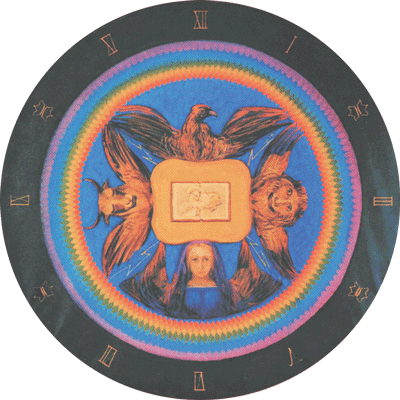
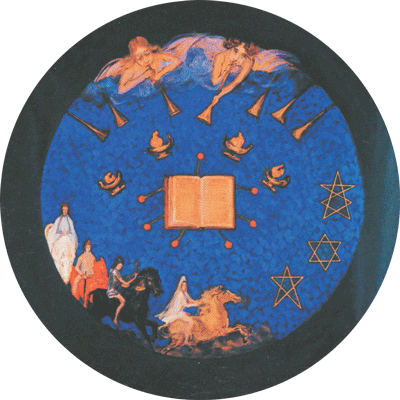

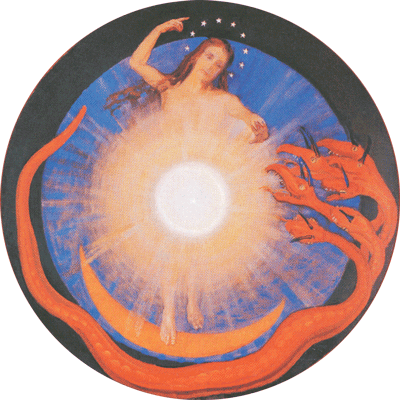

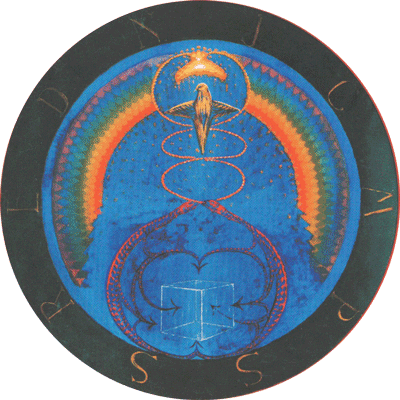
7th seal: the Mystery of the Holy Grail. The Cube represents space [the cosmos]. The two serpents represent the lower human powers that grow out of the cube. These bring forth out of themselves the purified higher spiritual nature, represented by the world spirals. The upward growth of these higher powers makes it possible for a human being to become a recipient, or chalice, of purely spiritual cosmic being, expressed in the dove. Thereby humanity becomes the ruler of spiritual cosmic forces, portrayed in the rainbow.
The opening paragraphs and the descriptions of each of the seals below are taken from "Painting the Invisible" website, a website dedicated to Arild Rosenkranz.
[This is] a series of paintings which Rosenkrantz himself considered among his most important: The Seven Apocalyptic Seals.
Rosenkrantz painted the seals for the first time in 1923 under the personal guidance of Rudolf Steiner. They were published in 1924 in black and white in an English portfolio edition: "Occult Seals and Columns". The seven pastels shown here and in the video are painted by Rosenkrantz in London in the 1930s. The originals have a diameter of 72 cm's. They are all privately owned in Denmark.
Rudolf Steiner's own interpretation of the seals from 1907 can be found in John Fletcher's "Art inspired by Rudolf Steiner" (Mercury Arts Publication 1987). Steiner emphazies that "all speculations and intellectual explanations are out of place in dealing with such signs, since they are not arrived at by thought, but are purely a description of what the so-called seer perceives in unseen worlds. One who is able to understand that book as interpreted by spiritual science, sees in it nothing else than a description in words of what the seer percieves as human evolution on the astral plane in archetypes".
The abbreviated explanations here are quoted from John Fletcher's book with one quote from Emil Bock.
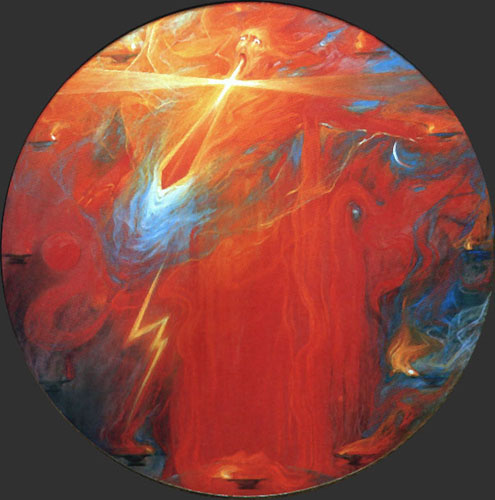
Seal No. 1: The mystery of the creative word
The mystery of the creative word represents comprehensively the entire earthly evolution of man. The images in this and the other seals can be found in "The Revelation of St. John" or the Apocalypse. "And I turned to hear the sounds which reached me; then I saw seven golden lamps, and in the midst of the lamps one like unto the Son of Man, in a long garment... with eyes as a flame...and feet of living fire... and a voice like the sound of many waters. And in his right hand were seven stars, and out of his mouth came a sharp two-edged sword, and his countenance was as the sun shineth in his strength."
"Here," Steiner writes, "in general images, most far-reaching mysteries of human evolution are indicated... Every sign and form in the seals is significant... This continous development from the beginning to the end of the earth reveals itself to the seer, when he sees on the astral plane the archetype of evolving man, as it is reproduced in the first seal."

Seal No. 2: The group soul
The group soul represents one of the first evolutionary states of earthly humanity, with all that belongs to it. In the remote past humans had no individual soul but were part of a group-soul. On the astral plane this may be reduced to four fundamental types: the lion, ox, eagle and that form, which as a group soul comes closest to the individual soul of human beings today. But as yet, as Emil Bock writes in his "Apocalypse of St. John", everything is filled with divine calm and solemnity. Creation still rests in the sphere of perpetuity; the wheel of time is not yet revolving. The hierarchical realm which contains the creatures is full of wonder and worship, absorbed in contemplation of the creative cosmic centre. In the centre Rosenkrantz has placed the lamb — the only one worthy of opening the seals.
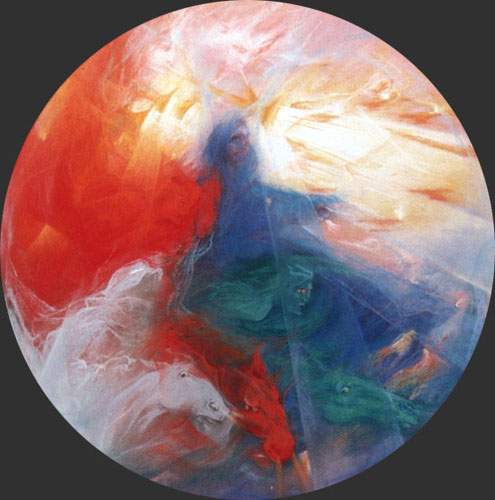
Seal No. 3: The four riders
The four riders (the harmony of the spheres) represent the mysteries of the so-called harmony of the spheres. You experience these mysteries, Steiner says, in the interval between death and a new birth. The angel blowing the horns represents the spiritual primordial essences of world-phenomena.The apocalyptic riders represent the main points of development, through which a human individuality passes in the course of many incarnations and which are represented on the astral plane in the four riders on horses: a shining white horse expressing a very early stage of soul development; a flamecoloured horse indicating the warrior stage of the soul's development; a black (or blue) horse corresponding to the stage when only the soul's outer physical perception is developed, and a gleaming green horse, the picture of the ripe soul, which has gained mastery over the body.
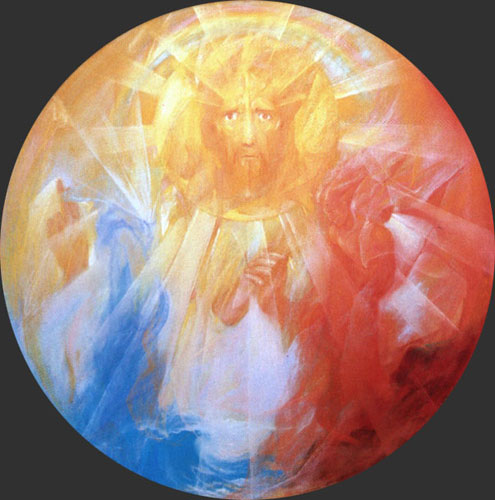
Seal No. 4: The two pillars
The two pillars — one rising out of the sea, the other out of the land. In these pillars is indicated the mystery of the part played in human evolution by red, or oxygenated blood, and blue, or carbonated blood. The human ego passes through its evolution in the earth's cycle by bringing its life to physical expression in the action and reaction upon each other and red blood, without which there would be no life, and blue blood, without which there would be no knowledge.
A future state is here represented by the figure with a face which has acquired the sun's spiritual forces. At that time human beings will no longer acquire knowledge from without, but will have devoured it, as the words in the Revelation say: "And I took the little book out of the angel's hand, and ate it up..."
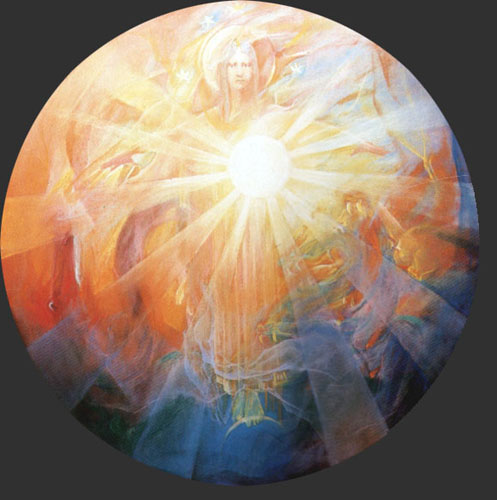
Seal No. 5: The woman clothed in the sun
The woman clothed in the sun represents a higher stage of human evolution, as it will take place when the earth will have once more united with the sun and human beings will no longer work merely with earth forces but with sun forces. The woman "whom the sun brings forth" relates to this human being of the future. Certain lower forces are represented in the seal — in the dragon with the "seven heads and ten horns" and in the moon under her feet. In spiritual science the moon is the center of lower forces which are still active in human nature, but will in the future be put under the feet of humanity.
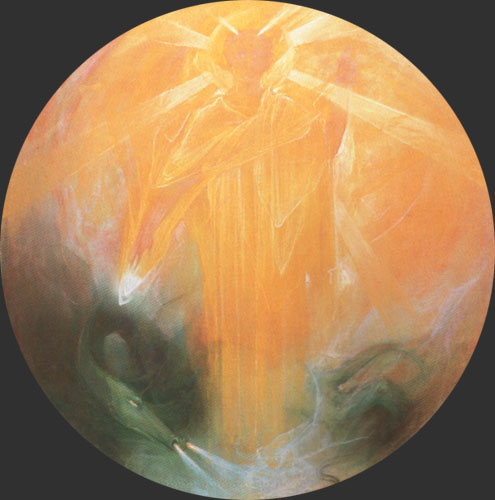
Seal No. 6: Michael and the dragon
Michael and the dragon represent the purified human being, not only spiritualized but grown strong in spirituality, who has not only subdued the lower forces, but so transformed them that, changed for the better, they are at the service of humanity. The tamed dragon expresses this. "And I saw an angel come down from heaven, having the key of the bottomless pit and a great chain in his hand. And he laid hold on the dragon, that old serpent, which is the devil, Satan, and bound him a thousand years."

Seal No. 7: The mystery of the holy grail
The mystery of the holy grail. It is that astral experience which renders the universal meaning of human evolution. The cube represents the world of space, not yet mingled with any physical being or event. Out of the three space dimensions grow first of all the lower human powers, illustrated by the two serpents; these again bring out of themselves the purified higher spiritual nature, represented in the world spirals. The upward growth of these higher powers makes it possible for mankind to become the recipient, or chalice, of purely spiritual cosmic being, expressed in the dove. The motto and truth of spiritual science is inscribed here: I am born out of the Godhead; I die in Christ; I am born again through the holy Spirit.
From Rosenkrantz's Bio:
Rosenkrantz felt he had a mission in carrying out Steiner's ideas of using the spectral colours in order to reach the invisible spiritual reality which lies behind the material, and it was his wish that as many as possible should be able to experience this. He painted many versions of the motifs he found especially important, such as Golgotha, The Last Supper, The Hierophant, Madonna, Michael, Wisdom, The Messenger, and the series of four pictures from the Creation: The Mineral World, The Plant World, The Animal World and Man — and The Seven Apocalyptic Seals .